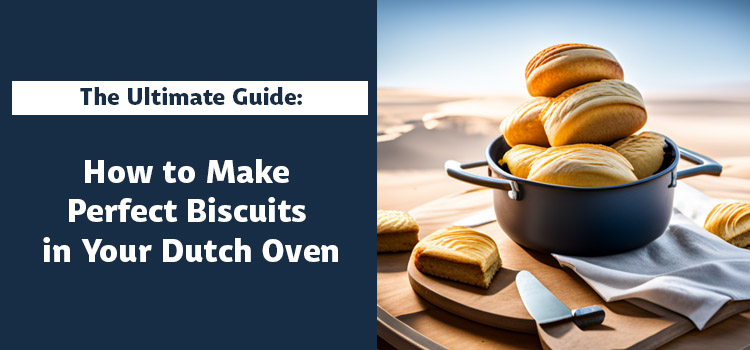As an Amazon Associate, I earn from qualifying purchases
The Ultimate Guide: How to Make Perfect Biscuits in Your Dutch
Oven

There’s a certain magic in the simplicity of homemade biscuits. They embody comfort, warmth, and the unmistakable aroma of baking in a lovingly seasoned Dutch oven. If you’re new to the world of Dutch oven cooking or are looking to elevate your biscuit game, you’re in the right place. In this comprehensive guide, we’ll walk you through every step, from picking the right ingredients to savoring the first bite of your perfect flaky biscuit.
There’s something special about the process of baking in a Dutch oven. Its ability to trap moisture and circulate heat creates an ideal environment for baking biscuits that are golden on the outside and tender on the inside. We’ll turn your kitchen into a biscuit haven, and with a little practice, you’ll be delighting in biscuits that would make even a seasoned baker smile.
Choosing the Right Ingredients
The beauty of biscuits lies in their simplicity, where a handful of ingredients transforms into a delectable delight. Here’s a breakdown of each:
Flour
Start with all-purpose flour — it’s the workhorse of this recipe. For lighter biscuits, consider pastry flour which has a lower protein content.
Fat
A classic biscuit recipe calls for a fat source; usually, it’s chilled butter or shortening. The cold fat melts as it bakes, creating those sought-after flaky layers.
Leavening Agents
Baking powder and sometimes, baking soda are responsible for the rise in your biscuits. Be mindful of expiration dates to ensure they are doing their job.
Liquid
Typically milk or buttermilk, the liquid hydrates the flour and helps create gluten formation. Buttermilk will also add a lovely tang to your biscuits.
Salt
Salt is essential for flavor in any baked good, it’s the unsung hero that balances and enhances other tastes.
Optional Add-Ins
For a sweet variation, consider adding sugar and a bit of vanilla. When going savory, fresh herbs or shredded cheese can take your biscuits to the next level.
Ingredient quality is crucial here; always reach for the freshest, highest quality ingredients you can find. This might mean skipping the pantry basics in favor of organic or local produce and dairy. The difference in taste is worth the extra investment.
Preparing the Dutch Oven
Properly seasoning your Dutch oven is a must as it prevents sticking and improves with each use.
Seasoning
- Wash your Dutch oven with soapy water.
- Towel dry and place the pot over a burner set to low.
- Rub a thin layer of vegetable oil over the entire Dutch oven, including the lid and the bottom.
- Keep the oven over a low flame until the oil starts to smoke.
- Remove from heat and wipe off any excess oil with a paper towel.
Now that your Dutch oven is seasoned, preheat it in your oven before you start making your biscuits.
Preheating
- Place the Dutch oven, with the lid on, in your oven.
- Preheat to the temperature required for your biscuit recipe.
- The Dutch oven should be hot when the biscuits go in.
A note on Dutch oven lids: Some argue that the lid can transfer too much heat to the top of your biscuits, over-browning or even burning them. A simple remedy is to place a layer of parchment paper over the biscuits before you put the lid on.
Making the Biscuit Dough
The key to great biscuit dough is to handle it as little as possible. Over-mixing can make biscuits tough, so keep a light touch.
Step-by-Step
- Mixing the Dry Ingredients: In a large bowl, whisk together your flour, leavening agents, salt, and any dry additives like sugar or cheese.
- Incorporate the Fat: Cut cold butter or shortening into the dry mixture. You can use a pastry cutter or your fingers, rubbing the mixture between your palms. The result should resemble coarse crumbs with a few pea-sized pieces of butter still visible.
- Add the Liquid: Pour the milk or buttermilk into the bowl, then gently fold the wet and dry ingredients together. The mixture should be shaggy — a dough that’s a little rough and uneven.
- Kneading (Sparingly): Turn the dough out onto a lightly floured surface and knead it a few times until it just comes together. Pat it into a disk about 1-inch thick.
- Cutting the Biscuits: Use a round cookie cutter or just the rim of a straight-sided glass to cut the biscuits. Press straight down without twisting to ensure the dough has a clean edge for maximum lift.
Remember, your hands, tools, and even the mixing bowl should be as cold as possible. The cold temperature of the fat and even the flour help to keep the dough from warming up and getting sticky too soon.
Baking the Biscuits
With your Dutch oven ready and your biscuits formed, it’s time to bake.
Setting the Scene
- Open the preheated oven and take the Dutch oven out.
- Arrange the biscuits in a single layer around the bottom, touching slightly.
- If there’s room, consider adding a few more biscuits in the middle.
Timings and Troubleshooting
- Bake according to your recipe’s instructions.
- You may want to check on your biscuits about halfway through the baking time. If the tops are browning too quickly, you can tent with a piece of foil to slow down the browning process.
- After the initial bake time, use a toothpick to check for doneness. It should come out clean, and the biscuits should be golden and flaky.
Remember, like any baking, times can vary with ovens and locations. It’s important to use these times as guidelines and rely on your best judgment.
Variations and Serving Suggestions
Customization is the fun part of making biscuits. Here are a few ideas to get you started:
Adding Flavor
- Fold in fresh herbs like chives or parsley for a savory kick.
- Mix in a handful of shredded cheddar for a rich and cheesy bite.
- For a sweet treat, sprinkle the tops with cinnamon sugar before baking.
Serving
- Pair your biscuits with a hearty stew, chili, or a simple smear of butter and jam for breakfast.
- Use them to sop up gravy or as the base for a biscuit breakfast sandwich.
The possibilities are endless, so don’t be afraid to get creative with your biscuit recipes.
Perfecting biscuit-making in your Dutch oven is a delightful blend of culinary skill and personal taste. Celebrate the process as much as the end result, and be open to experimentation. Whether you’re using your Dutch oven on your next camping trip or just enjoying the rustic joys of home cooking, your biscuits are sure to be remembered fondly. Happy baking!
As an Amazon Associate, I earn from qualifying purchases
